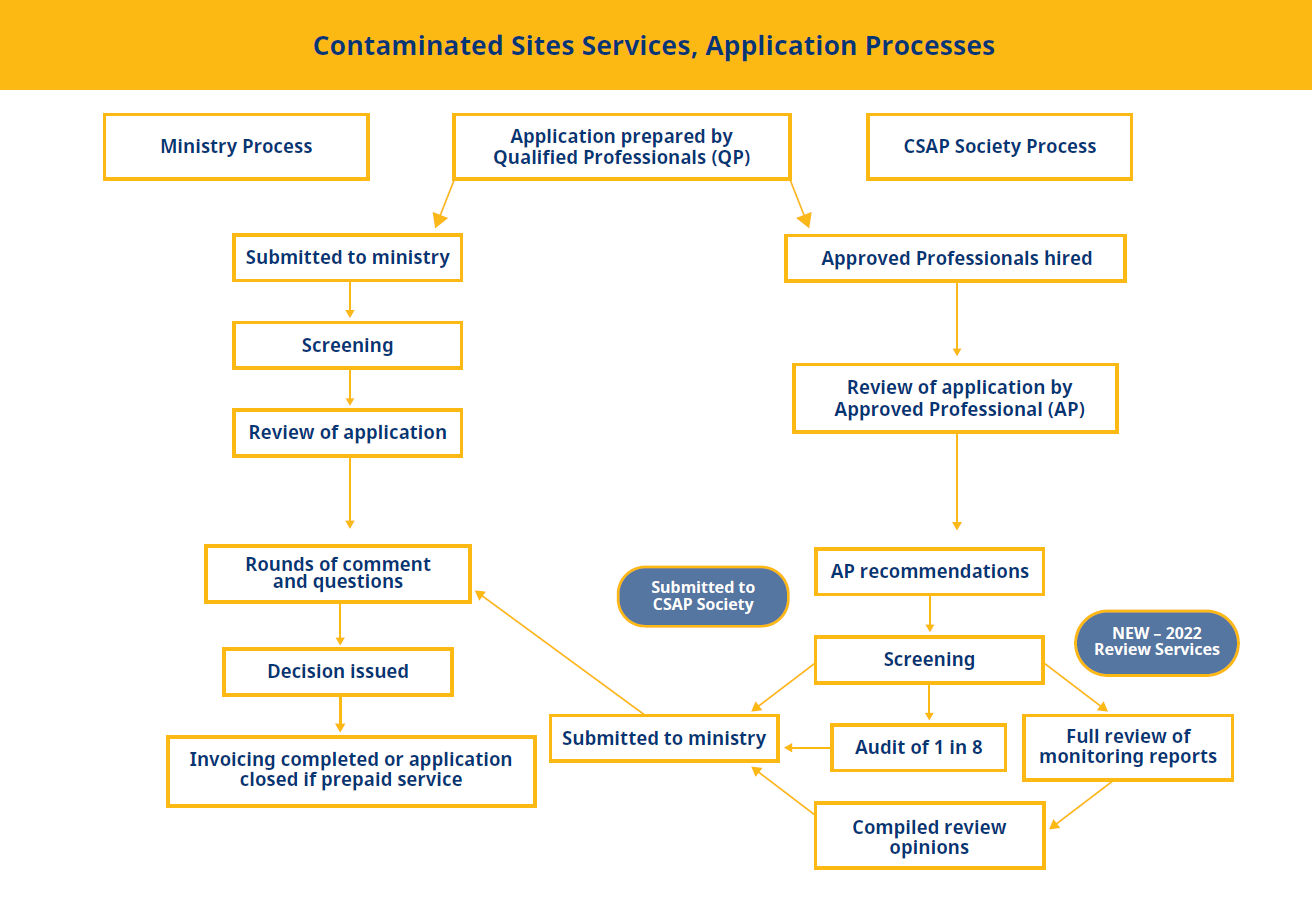Professional reliance
If you're applying for contaminated sites services, you need to employ the services of a professional with contaminated sites expertise.
Professionals may also need to work with the Contaminated Sites Approved Professional Society (CSAP).
On this page
- Professionals with contaminated sites expertise
- CSAP Society
- Contaminated sites application process flowchart
- Resources
Professionals with contaminated sites expertise
There are 2 types of professionals who have expertise in contaminated sites legislation:
These professionals help you complete your contaminated site requirements and guide you through the site remediation process.
They must have the necessary knowledge, skills and objectivity to:
- Provide sound and impartial advice and recommendations
- Support the best environmental outcomes
- Protect public interests
The type of professional to consult depends on your situation and the service you're applying for.
You may need to work with both a QP and an AP.
Qualified Professionals (QP)
A QP is a person who:
- Is registered in B.C. with a professional association
- Acts under that professional association's code of ethics
- Is subject to disciplinary action by that professional association
- May be reasonably relied on to provide advice within their area of expertise, through suitable education, experience, accreditation and knowledge
Qualified Professional services
Within the B.C. professional reliance model, QPs are relied on to:
- Complete site investigation and remediation
- Prepare application packages and notification documents for submission to the ministry
- Provide support for APs
Approved Professionals (AP)
Approved Professionals (AP) are qualified professionals who have been appointed to the ministry’s Roster of Approved Professionals under Section 42 of the EMA.
APs are members of the Contaminated Sites Approved Professional Society (CSAP) and are registered:
- Professional agrologists
- Biologists
- Chemists
- Engineers
- Geoscientists
Approved Professional services
Applications for ministry certification documents submitted through the CSAP process must be submitted with AP recommendation.
Activities that may or must be performed by an AP for non-high risk sites can be found in:
This includes:
- Certificates of Compliance
- Approvals in Principle of a remediation plan
- Determinations of a Contaminated Site
Certification document applications
AP services relating to certification document applications include:
- Reviewing investigation report(s), remediation plan and/or confirmation of a remediation report
- Completing a Summary of Site Condition (SoSC), which includes a recommendation to issue the certification document being sought
- Drafting the ministry certification document
- Submitting these documents along with the application form to the CSAP Society for screening
Other AP services
AP services may also be required to:
- Fulfil the conditions of a certification document
- Obtain a release under the site identification process and subsequent requirements listed in the release
- Classify a site under Protocol 12: Site Risk Classification, Reclassification and Reporting (Revised) (PDF, 737KB)
Once a certificate or a release is issued by the ministry, it often contains conditions or requirements. For example, that an approved professional must submit an annual statement saying the conditions continue to be met.
AP recommendations
APs may also provide recommendations where required by the director on any of the following:
- Monitoring reports
- Fluxes in concentrations of substances at a site
- Appearance of new substances at a site
- Adequacy of investigations at a site
- Risk classification of a site
- Adequacy of a remediation plan, when implemented, to appropriately manage contamination at a site
Visit Apply for services to learn more about information on site remediation processes.
CSAP Society
When you employ an AP, they may work with the CSAP Society to complete your applications.
CSAP services
The CSAP Society provides the following services:
- Reviewing applications for Determinations, AiPs and CoCS for non-high risk sites
- All submissions with AP recommendations for non-high risk sites must go through the CSAP Society for screening to ensure that the required documents are included in the application package and to confirm specific details about the site
- Complete applications are forwarded to the ministry
- Performance audits on submissions (reviewing the work of APs)
- The CSAP Performance Assessment Committee (PAC) conducts performance assessments on one in 8 submissions for Certificates of Compliance, Approvals in Principle of a remediation plan, or Determinations of a Contaminated Site.
- For more information on performance assessments, review the Guidelines for Performance Assessment of Submissions by Contaminated Sites Approved Professionals.
Role of CSAP Society Review Service Committee
The CSAP Society Review Services Committee (RSC) provides screening and technical review of documents that are submitted to meet the director’s imposed requirements.
These are usually annual reports or statements that are prepared to address conditions found in Schedule B of a certification document:
- For example, an Approval in Principle or a Certificate of Compliance
Through your approved professional, you need to submit these reports for review directly to CSAP, along with:
- A CSSAF
- Applicable review fee
After they review your reports, the RSC sends their finding to the ministry director for consideration.
For more information on the CSAP review process visit:
- CSAP's Report review services or
- Site Remediation's Apply for services
Contaminated Sites Service Application flowchart
The following flowchart shows the 2 main pathways for contaminated sites applications.
It outlines the roles of the:
- Ministry
- Qualified Professionals
- Approved Professionals
- CSAP Society
Applications related to the site identification process (Site Disclosure Statements and releases) are not included in the flowchart.
Resources
Subscribe to:
Laws and regulations
- Section 42: Environmental Management Act (EMA)
- Sections 15, 43, 47, 49 and 49.9: Contaminated Sites Regulations (CSR)
The information on this web page does not replace the legislative requirements in the EMA or its regulations and it does not list all provisions for contaminated site services.
If there are differences between this information and the Act, Regulation, or Protocols, the Act, Regulation, and Protocols apply.

